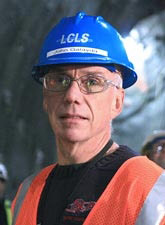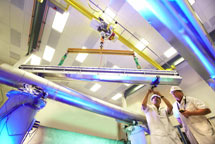
Handy Links
SLAC News Center
SLAC Today
- Subscribe
- Archives: Feb 2006-May 20, 2011
- Archives: May 23, 2011 and later
- Submit Feedback or Story Ideas
- About SLAC Today
SLAC News
Lab News
- Interactions
- Lightsources.org
- ILC NewsLine
- Int'l Science Grid This Week
- Fermilab Today
- Berkeley Lab News
- @brookhaven TODAY
- DOE Pulse
- CERN Courier
- DESY inForm
- US / LHC
SLAC Links
- Emergency
- Safety
- Policy Repository
- Site Entry Form

- Site Maps
- M & O Review
- Computing Status & Calendar
- SLAC Colloquium
- SLACspeak
- SLACspace
- SLAC Logo
- Café Menu
- Flea Market
- Web E-mail
- Marguerite Shuttle
- Discount Commuter Passes
-
Award Reporting Form
- SPIRES
- SciDoc
- Activity Groups
- Library
Stanford
Around the Bay
From the Director of LCLS Construction: My Thanks to the LCLS Collaboration and SLAC

In my life before SLAC, I had the privilege to participate (in various capacities) in the design, construction and commissioning of two linacs, two synchrotrons, four storage rings and three FELs (free-electron lasers). Now I have had the privilege to be in SLAC's Main Control Center on April 10, when the Linac Coherent Light Source became a 1.5 angstrom laser. I don't expect I will ever, as long as I live, see such a beautiful, smooth turn-on of any light source. With each undulator placed on the beam path, the FEL power increased by a factor of about 2.3; two hours into the first attempt at lasing, the pinpoint of FEL light from twelve undulators was nearly 2,000-fold more intense than plain old undulator radiation. The team called it quits at 11:30 p.m. that night. When they returned at 8 a.m. the next morning, the FEL light came back as soon as the shutter was opened.
The FEL power is much higher now, only two weeks later.
I am in awe of the near-perfection to which LCLSers from every corner of every department of SLAC worked in partnership with LCLS collaborators at UCLA and Argonne National Laboratory to make the first operation of the FEL look as simple as turning on a light switch. To make the LCLS lase required a photocathode gun and laser that didn't quite exist yet, producing an electron beam of near-impossibly small size and high current, shot through a 5-millimeter-diameter pipe threading through a 130-meter-long undulator. The electron beam must literally travel as straight as a light beam, with only a few—5 or so—micrometers' room for error. To put that into perspective, a sheet of notebook paper is 50 micrometers thick. And it all worked just right, from the first attempt.
How did the LCLS collaboration members make it go so well? They met an extraordinary set of milestones: Get the beam physics right. Get the engineering designs right. Build and test prototypes to confirm and improve performance. Produce that incredible undulator system. Get the magnet measurements right to within 0.01 percent. Get every critical component fiducialized and aligned almost perfectly. Get the radio-frequency-induced jitter in the beam down to 46 femtoseconds, about of time it takes light to travel one third the thickness of that sheet of notebook paper. Get installation and checkout right. Get everything under automated computer control in a convenient, reliable way. Draw on 40 years' experience with the linac to anticipate and control every phenomenon and hardware characteristic that might affect performance. Get everything upstream of the undulator under automated control so you don't have to think about it much while you are commissioning the FEL. Keep all that hardware in proper repair. Fix every hardware problem so that either it won't come back, or you can control it with preventative maintenance.
While all that is going on, design and build the most stable accelerator housing you can. Commission a super-stable temperature control system.
Install about 52 miles of cable and fiber, terminate/label/check each cable, connect them all where they belong and log them into the database.
Do this all without any compromise in safety, in the area of design or work planning. Don't let a single LCLS worker get hurt.
Get the project planning, budget control, procurement, work supervision, contract administration right so that all of it comes together on time and on budget.
Do this all and, baddabingbaddaboom! You have the world's first hard X-ray laser working right out of the box. Amazing.
Thank you all for giving me the experience of a lifetime. And the ride is not over yet by any measure. There is a lot of work to go, and operation too… and I think I can make out the shape of Undulators 2 and 3 coming over the horizon.
For the present, we have an X-ray beam that, when tuned and focused, might tear the atoms out of any sample material put in its way. Since 1998 the LCLS team at Livermore has been preparing to meet this beam, measure its properties and control it. The builders of the first LCLS scientific instrument—the Atomic, Molecular and Optical physics instrument, or AMO—are getting ready for scientific experiments in September. LCLS is ready for a very interesting summer.

